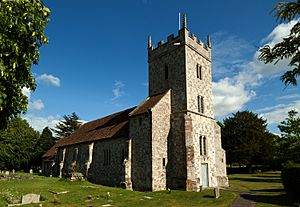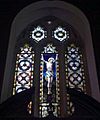St Lawrence, Stratford-sub-Castle facts for kids
St Lawrence's Church is an old and beautiful church located in the village of Stratford-sub-Castle, near the city of Salisbury in England. It was built a very long time ago, in the 1200s! This church is part of the Church of England and is considered a very important historical building, known as a Grade I listed building. It stands close to the ancient, empty town of Old Sarum and the River Avon. It's also about 3 kilometers (or 2 miles) north of the famous Salisbury Cathedral.
Contents
Building the Church: Its History and Look
The church is at the northern end of Stratford-sub-Castle village. Long ago, a medieval village surrounded it.
How Old Is St Lawrence's Church?
People first mentioned a chapel here in 1228. It was connected to St Martin's church nearby. We know there was an even older building because walls and floors from the 1100s or 1200s were found in the churchyard in 2008. The part of the church where the altar is, called the chancel, was built in the early 1200s. You can see this from its arch and a window that is now blocked up. The church was officially blessed in 1326, but we don't know why that specific year was chosen.
What Does the Church Look Like?
The tall tower at the west end of the church was built in the 1200s or 1300s. It was rebuilt in 1711 by a rich merchant named Thomas Pitt. He had bought the land around Old Sarum. The main part of the church, called the nave, was built in the 1400s. Over the next two centuries and around 1711, parts of the church were changed and fixed. This included replacing windows. The special ceiling, called a wagon roof, has carved decorations and is from the 1500s.
The church is built with flint and stone, sometimes in a checkerboard pattern. It might even have stones from the old Old Sarum Cathedral. Two stones have a diamond pattern typical of Norman architecture, which is a very old style. In 1972, the church was officially recognized as a Grade I listed building. This means it's one of the most important historic buildings in England.
Inside the Church: Special Features
The inside of St Lawrence's Church is very beautiful. Many parts of it have interesting stories.
The Font and Ceilings
The font, where baptisms happen, is made of a special stone called Purbeck marble. It's probably from the late 1100s. It might have been moved here from another place. The bowl of the font was originally square. But its corners were cut off to make it eight-sided. So, four sides have carvings, and four are plain. The base of the font is more modern.
The ceilings in the nave and chancel are shaped like wagon roofs. They are from the late 1500s. They have carved wooden faces and busts (head and shoulders sculptures) where the beams meet. The tall pulpit, where the priest gives sermons, is from the early 1600s. It has a special canopy above it.
The Chancel Screen and Altar Area
The screen that separates the chancel from the nave might have been put together around 1711. It has a round arch from that time, placed into an older structure from the 1400s or 1500s. Also from around 1711 is the tall wooden paneling behind the altar. This paneling is very impressive and detailed.
The window in the altar area has panels on either side with the Ten Commandments. The reredos, which is a decorated screen behind the altar, has beautiful carvings of leaves, columns, and a broken triangular top. The rail around the altar has fancy turned wooden posts. There are also wooden panels along the lower walls and pews (church benches) with panel fronts. A very detailed royal coat of arms from 1713 is also inside.
Organ and Stained Glass
The gallery at the west end of the church is from around 1800. It holds the organ. The organ was built in 1852 as a barrel organ, which played music automatically. It was changed in 1876 to be played with a keyboard. The only important stained glass window is the one at the east end, made in 1894. It was created by a company called Lavers and Westlake. The church's inside was carefully restored in 1905 by an architect named W. D. Caröe.
The Church Bells
In 1553, the church had three bells. But one was sold in 1584. In 1998, another original bell was sold. Five new bells were then hung. The last original bell, from 1594, was kept as the highest-pitched bell. Now, there are six bells in total.
Churchyard: A Place of Remembrance
The churchyard is the area around the church where people are buried. It holds special meaning for many.
War Graves
A part of the churchyard has the graves of 52 soldiers and service people. They died during World War I and World War II. The Commonwealth War Graves Commission takes care of these graves. Most of the graves from World War I (47 of them) are for soldiers who were in local war hospitals. About half of these were Australian soldiers. A large stone cross, called a Cross of Sacrifice, stands over these graves.
War Memorial
Between the church and the road is the village's war memorial. It was put up in 1922. This memorial is a tall, tapering limestone pillar. It has a carved image of the crucifixion at the top, covered by a small roof. The whole memorial is about 5 meters (16 feet) tall.
The Church Community
St Lawrence's Church has a long history of serving its local community.
Parish History
Even though St Lawrence's was technically a smaller chapel of St Martin's church until at least 1701, people thought of it as its own parish church from 1394 or even earlier. It had its own graveyard and a place for baptisms.
In 1937, some of the parish land was used to create a new parish for St Francis's Church. This was because the northern parts of Salisbury were growing. The area of Old Sarum was added to Stratford-sub-Castle parish in 1953. There were more changes to the boundaries of St Lawrence and St Francis parishes in 1968. Today, these two parishes work together as one group, even though they are still separate churches.
The church's old records, like lists of baptisms and weddings, go back to 1654. The records that are not used every day are kept safe at the Wiltshire and Swindon History Centre in Chippenham.
Images for kids






